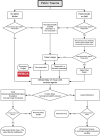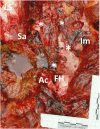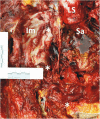Technical limitations of REBOA in a patient with exsanguinating pelvic crush trauma: a case report
- PMID: 31285757
- PMCID: PMC6592001
- DOI: 10.1186/s13037-019-0204-6
Technical limitations of REBOA in a patient with exsanguinating pelvic crush trauma: a case report
Abstract
Background: Resuscitative endovascular balloon occlusion of the aorta (REBOA) is an effective adjunct in hemodynamic unstable patients with uncontrolled and non-compressible torso hemorrhage promoting temporary stability during injury repair. The aim of our study was to analyze real life usability of REBOA based on a case report and to review the literature with respect to its possibilities and limitations.
Case presentation: We present the case of a 17-years old female patient who sustained a severe roll-over trauma and pelvic crush injury as a bicyclist by a truck. Upon arrival of the first responders, the patient was awake, alert, and following commands.Subsequent to lifting the truck, the patient became hypotensive and required cardiopulmonary resuscitation, application of a pelvic binder, and endotracheal intubation at the accident scene. She was then admitted by ambulance to our trauma center under ongoing resuscitative measures. After primary survey, it was decided to perform a REBOA with surgical approach to the left femoral artery. Initial insertion of the catheter was successful but could not be advanced beyond the inguinal region. Hence, the patient was transferred to the operating room (OR) but died despite maximum therapy. In the OR and later autopsy, we found a long-distance ruptured and dehiscent external iliac artery with massive bleeding into the pelvis in the context of a bilateral vertical shear fractured pelvic bone.
Conclusion: REBOA can be a useful adjunct but there is a major limitation with potential vascular injury after pelvic trauma. In these situations, cross-clamping the proximal aorta or pre-peritoneal pelvic packing as "traditional" approaches of hemorrhage control during resuscitation may be the most considerable methods for temporary stabilization in severely injured trauma patients. More clinical and cadaveric studies are needed to further understand indications and limitations of REBOA after severe pelvic trauma.
Conflict of interest statement
Competing interestsThe authors declare that they have no competing interests.
Figures





Similar articles
-
Pre-hospital Resuscitative Endovascular Balloon Occlusion of the Aorta (REBOA) for exsanguinating pelvic haemorrhage.Resuscitation. 2019 Feb;135:6-13. doi: 10.1016/j.resuscitation.2018.12.018. Epub 2018 Dec 27. Resuscitation. 2019. PMID: 30594600
-
Resuscitative endovascular balloon occlusion of the aorta for control of noncompressible truncal hemorrhage in the abdomen and pelvis.Am J Surg. 2016 Dec;212(6):1222-1230. doi: 10.1016/j.amjsurg.2016.09.027. Epub 2016 Sep 30. Am J Surg. 2016. PMID: 28340927
-
Resuscitative endovascular balloon occlusion of the aorta for pelvic blunt trauma and life-threatening hemorrhage: A 20-year experience in a Level I trauma center.J Trauma Acute Care Surg. 2018 Mar;84(3):449-453. doi: 10.1097/TA.0000000000001794. J Trauma Acute Care Surg. 2018. PMID: 29298239
-
Resuscitative Endovascular Balloon Occlusion of the Aorta for Hemorrhage Control in Trauma Patients: An Evidence-Based Review.J Trauma Nurs. 2018 Jan/Feb;25(1):33-37. doi: 10.1097/JTN.0000000000000339. J Trauma Nurs. 2018. PMID: 29319648 Review.
-
Partial Versus Complete Resuscitative Endovascular Balloon Occlusion of the Aorta in Exsanguinating Trauma Patients With Non-Compressible Torso Hemorrhage.Cureus. 2020 Jul 4;12(7):e8999. doi: 10.7759/cureus.8999. Cureus. 2020. PMID: 32775079 Free PMC article. Review.
Cited by
-
Resuscitative Endovascular Balloon Occlusion of the Aorta (REBOA): update and insights into current practices and future directions for research and implementation.Scand J Trauma Resusc Emerg Med. 2021 Jan 6;29(1):8. doi: 10.1186/s13049-020-00807-9. Scand J Trauma Resusc Emerg Med. 2021. PMID: 33407759 Free PMC article. Review.
-
Safety or speed? Assessing alternative vascular access for angiography after resuscitative endovascular balloon occlusion of the aorta (REBOA) in severe pelvic trauma patients.Trauma Surg Acute Care Open. 2025 Jan 4;10(1):e001530. doi: 10.1136/tsaco-2024-001530. eCollection 2025. Trauma Surg Acute Care Open. 2025. PMID: 39845986 Free PMC article.
-
A descriptive survey on the use of resuscitative endovascular balloon occlusion of the aorta (REBOA) for pelvic fractures at US level I trauma centers.Patient Saf Surg. 2019 Dec 13;13:43. doi: 10.1186/s13037-019-0223-3. eCollection 2019. Patient Saf Surg. 2019. PMID: 31857823 Free PMC article.
-
Management of pelvic injuries in hemodynamically unstable polytrauma patients - Challenges and current updates.J Clin Orthop Trauma. 2021 Jan;12(1):101-112. doi: 10.1016/j.jcot.2020.09.035. Epub 2020 Oct 6. J Clin Orthop Trauma. 2021. PMID: 33716435 Free PMC article.
-
Effect of C-Clamp Application on Hemodynamic Instability in Polytrauma Victims with Pelvic Fracture.Medicina (Kaunas). 2022 Sep 16;58(9):1291. doi: 10.3390/medicina58091291. Medicina (Kaunas). 2022. PMID: 36143972 Free PMC article.
References
-
- Otsuka H, Sato T, Sakurai K, Aoki H, Yamagiwa T, Iizuka S, et al. Effect of resuscitative endovascular balloon occlusion of the aorta in hemodynamically unstable patients with multiple severe torso trauma: a retrospective study. World J Emerg Surg. 2018;13:49. doi: 10.1186/s13017-018-0210-5. - DOI - PMC - PubMed
-
- Adnan SM, Wasicek PJ, Crawford A, Dubose J, Brenner M, Scalea TM, et al. Endovascular control of pelvic hemorrhage: concomitant use of REBOA and endovascular intervention. J Trauma Acute Care Surg. 2018;86:155–59. - PubMed
-
- Matsumura Y, Matsumoto J, Kondo H, Idoguchi K, Ishida T, Okada Y, et al. Early arterial access for REBOA is related to survival outcome in trauma. J Trauma Acute Care Surg. 2018;85:507–11. - PubMed
Publication types
LinkOut - more resources
Full Text Sources

